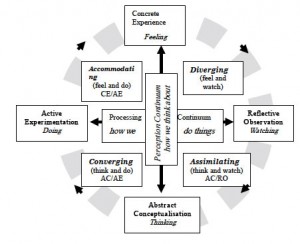All students vary in their style of learning and whilst some are quite critical of ‘learning styles’ perhaps they might be a helpful concept in which to guide you towards learning experiences that suit your style. Learning styles may be described as characteristic preferences for alternative ways of absorbing and processing information (Litzinger, Wise, & Felder, 2007). This concept was originally proposed by Kolb (1984) who devised a learning cycle, which incorporates four main approaches to learning:
- Concrete Experience (Feeling)
- Reflective Observation (Watching)
- Abstract Conceptualisation (Thinking)
- Active Experimentation (Doing)
Whilst, to some extent, every student should respond to each of the learning styles, everyone will inevitably have a preferred learning style and respond to this more and it appears that the majority of sport science students tend to lean more towards being ‘active learners’.
Felder and Solomon (2007) have found that a ‘guided discovery’ form of teaching helpful in the long term. Furthermore this style of teaching can promote more mastery and less performance-focused teaching behaviours andmore adaptive cognitive and affective responses than the command/practice style (Morgan, Kingston, & Sproule, 2005). That’s why the activities that we include can be beneficial for promoting more task orientated learning.
A more detailed model has been adapted and developed and these combined styles may help you understand your learning styles even further.
Accommodating – Feeling and doing
Diverging – Feeling and watching
Converging – Thinking and doing
Assimilating – Thinking and watching
As you can see from the model, Felder and Soloman (2007) further extend previous ideas of learning types. Not only are there ‘active’ and ‘reflective’ learners, there are also ‘sensing’ and ‘intuitive’ learners; ‘visual’ and ‘verbal’ learners; ‘sequential’ and ‘global’ learners; understanding which learning style you might be beneficial for you.
If you need a bit of assistance, then take an ‘informal test’ to see what learning style might suit you best (remember to take these results with a ‘pinch of salt’).
Allow 10-15 minutes
http://www.clinteach.com.au/assets/LEARNING-STYLES-Kolb-QUESTIONNAIRE.pdf

